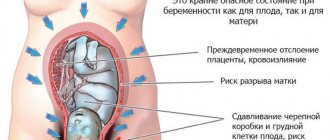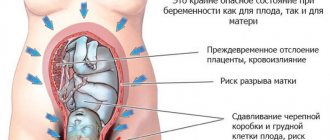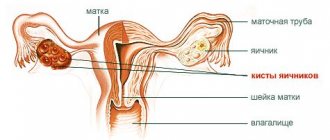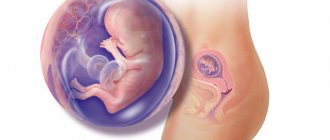Changes in the body at 36 weeks
Your body is large and clumsy due to a large belly and weight gained; many women gain up to 15 kg or even more by this time, so it is important to control your body weight. The appetite at this time is good, especially if the stomach begins to drop and the uterus no longer puts so much pressure on the stomach. The descent occurs about a couple of weeks before birth, this is especially noticeable in first-time mothers. In this case, the baby’s head lowers into the mother’s pelvic area due to the gradual preparation and smoothing of the cervix.
Training contractions often occur, but if you don’t feel them, it’s not dangerous; every woman prepares for birth differently. During training contractions there is no regularity and pain, the walls of the uterus contract without opening the cervix, and without pathological discharge. If, during training contractions, the stomach and lower back are pulled, this indicates the onset of labor, you must immediately go to the hospital. When training contractions intensify, which usually happens in the evening, you should just lie on your left side and rest. They pass quickly.
Difficulties appearing with sleep - because of the stomach, it is difficult to choose a comfortable position and can be tormented by insomnia, this is a kind of preparation for the postpartum period, when caring for the baby will require a lot of time. But you still need to sleep and have a good rest, find a comfortable position for yourself, drink less water at night, take a warm bath, give yourself a massage, take a walk before bed and ventilate more often.
It is important to move carefully and slowly, as the center of gravity is shifted and there is a risk of falls and injuries. To relieve your back and lower back, wear a special bandage, rest often and take a knee-elbow position. Because of the pressure, the bladder works more actively, and you will often need to go to the toilet, but there are difficulties with the intestines - frequent constipation. The legs swell greatly, which requires raising them to an elevated position and resting. By lowering the abdomen, it will become easier to breathe and shortness of breath and malaise will disappear.
Features of gestation
It is important for a pregnant woman to rest, take a walk, and go for weekly checkups. It is important to be careful and rise slowly.
Such advice will help prevent a condition when a patient is 36 weeks pregnant, has pain in the lower abdomen, and is bothered by a migraine.
It is advisable for pregnant women at any stage to wear comfortable shoes. It is important to spend time preparing for childbirth and going to courses. Pain, as during menstruation, is normal.
This is a physiological phenomenon. They often do not affect the health of the mother and baby. Discomfort during pregnancy is due to the growth and development of the person.
The uterus enlarges, causing a shift in the center of gravity and hormonal imbalance. The changes soften and relax the joints. Because of this, during pregnancy the hip joints, pubis, and pelvic area hurt.
During pregnancy, hemorrhoids may appear or become severely aggravated. This is the root cause of pain that radiates down the abdomen. This phenomenon refers to normal processes.
But to prevent complications, it is recommended to undergo examination by a gynecologist. If necessary, he will prescribe safe therapy. Self-medication in this case during pregnancy is unacceptable.
In late pregnancy, some medications can be taken. If the nagging pain in the abdomen intensifies, it is important to call a doctor immediately.
Intense pain may indicate oligohydramnios, which complicates the course of labor.
Soreness at 36 weeks is a symptom of impending childbirth. The syndrome is associated with spasms due to changes in the baby's position. The pain radiates to the back, lumbar area.
Abdominal pain, as during menstruation at 36 weeks, is in some cases provoked by training contractions. This condition worries almost all women at the end of pregnancy.
Abdominal discomfort indicates that the body is preparing for the upcoming birth. Usually the attack occurs spontaneously, goes away on its own and quite quickly.
It is dangerous when abdominal discomfort appears suddenly and is acute.
Fetal development at 36 weeks: weight, size and gender
The child has grown to approximately 47-48 cm, while weight can vary from 2.6 to 2.8 kg, depending on individual characteristics and the pace of development. The baby has round, plump cheeks, enough subcutaneous tissue has accumulated and the body is rounded. This will give the baby the opportunity to maintain body temperature after birth. It is increasingly difficult for him to move due to his size, he stretches and pushes more and more, moves his head, and all his movements are clearly felt by the mother. He actively sucks his fingers, plays with his umbilical cord, yawns, hiccups and opens his eyes. It is important to monitor the movements. The norm of movements is at least ten in 12 hours. If the movements are sluggish or too active, you should go for a walk; perhaps the child is not getting enough oxygen.
The skull has not yet completely ossified; there are sutures that allow the head to be configured during labor and pass the birth canal more easily. This is necessary to protect the delicate and sensitive brain of the fetus from injury. Now all the organs and systems of the fetus are almost ready for birth, and it is actively accumulating strength and nutrients to meet the new world. His lungs are fully mature, he can breathe on his own, hormones are actively released, which allows him to regulate his metabolism. The nervous system is improving, more and more new nervous connections and reflexes are being formed. Now the child has taken his final position. If he is in a breech position, then the question of the method of delivery will be decided
Etiology of the syndrome
Pain is a common symptom that accompanies pregnancy. There should be no reason for concern, since such a symptom is predominantly physiological in nature and additionally indicates the approach of labor.
Manifestations of this kind confirm that the body is intensively preparing for childbirth.
But abdominal pain, as during menstruation, is not always a physiological process. In some cases, pain is associated with uterine tone.
This is very alarming at this stage of pregnancy and is highly undesirable. Due to hypertonicity of the uterus, the baby may experience hypoxia. And in the future it will lead to early birth.
The symptom has a number of features. The clinic often manifests itself as pain in the back, lower lumbar region. The long course of this clinic requires a comprehensive examination.
In any case, you should not panic, especially at the end of pregnancy. This condition can greatly harm the baby.
You need to immediately lie down, rest and relax. Sometimes it happens that after relaxation the pain immediately subsides.
The last weeks of pregnancy are very responsible and difficult. Therefore, it is extremely important to monitor the condition of the pregnant woman and note any changes that occur.
It is better to go to the hospital or visit a doctor once again. At 36 weeks, these could well be real contractions, so you can count on anything.
What you definitely shouldn’t do is rely on chance and guess why it hurts at 36 weeks of pregnancy. Only the doctor will accurately determine the etiology of the process.
Often, discomfort at 36 weeks is associated with training contractions.
Don't forget, not all factors are so harmless. There is a list of very dangerous conditions that can harm mother and baby.
This is especially true in cases where pain at the 36th week is accompanied by bloody discharge from the vagina. This may well indicate a clinical picture of placental abruption.
This is a serious condition that poses a threat not only to the baby’s health, but also to his life. If symptoms of placental abruption appear at the 36th week, you need to see a doctor as quickly as possible.
You cannot self-medicate and wait at home for the condition to improve. Every minute can provoke the death of a child. Ignorance and uncertainty can only harm the health of the mother in labor.
Therefore, if you experience severe pain in the lower abdomen during pregnancy, there is a reason to go to the maternity ward.
The 36th week of pregnancy is the expected period for every pregnant woman. On the one hand, there is still time before childbirth, but on the other hand, the help of an obstetrician-gynecologist may be required at any time.
Therefore, doctors advise preparing for childbirth as early as the 7th month of pregnancy. It is at this time that the fetus is ready to be born and, if necessary, it can be placed in intensive care or in an incubator.
In any case, a premature baby requires more attention than a child born on time.
Childbirth at 36 weeks
If your belly has already dropped, labor will begin soon. On average, a couple of weeks pass from the moment the baby is born. But you need to prepare and always have identification documents, a medical insurance policy and an exchange card with you. If labor begins at the 36th week of pregnancy, everything will go well - children at this stage are fully viable and ready for extrauterine life. But it’s still worth waiting until the baby has time to accumulate weight and strength for independent living. Therefore, give up provoking factors - carrying heavy objects and moving furniture, physical activity, active sexual contacts. If your pregnancy is multiple, this period is quite favorable for the birth of babies.
If you feel regular contractions, your water breaks, or you have spotting, you should go to the hospital immediately. Most likely, labor has already begun.
- Cottage cheese casserole in the oven: delicious recipes
- Noise in the ears and head, causes and treatment. Folk remedies and medications for ear noise
- Turpentine baths according to Zalmanov at home
Main features of the 36-38th week
During this period, the unborn baby continues to rapidly gain weight. The movements of the fetus in the uterus are more active, and are usually accompanied by strong movements of the arms and legs. A woman must constantly listen to them, since during a normal pregnancy, the baby should produce about ten kicks within twelve hours.
It should also be noted that the baby already fully determines its position in the uterus at 36-37 weeks of pregnancy. The lower abdomen of expectant mothers at this stage feels tight precisely because the baby is almost ready to be born, so the woman’s body also prepares for this with regular contractions of the uterus. There may also be pain in the abdominal cavity and pubic area.
Feelings of the expectant mother
Frequent hiccups in a baby
The main sensations from this stage of pregnancy are increasing fatigue and the desire to give birth as soon as possible. The weight of the body and abdomen tires, limits movement and gives back pain, it is uncomfortable to sleep, heartburn and shortness of breath torment. You suffer from sudden changes in mood, an elated and cheerful mood is suddenly replaced by anxiety and tears, depression and fear of motherhood. It will be especially difficult if this is your first pregnancy and occurs after a long waiting period. Such women are very worried about the baby and his health, about how the process of his birth will go. You need to rest more, turn to loved ones for support, and do the pleasant chores of preparing a dowry.
This week, nausea and heartburn may occur due to stomach tightening, as well as diarrhea and vomiting, this is a kind of “cleaning” of the body. Due to intestinal compression, constipation develops, and then you should seek help from a doctor. There is severe swelling in the arms and legs, but the swelling will gradually go away, leading to weight loss.
Now your body is experiencing double stress, your heart pumps 50% more blood than before pregnancy, and your body is working at its maximum possible level. Weakness and tiredness, fatigue and a desire to sleep during the day may occur. Although nesting syndrome may also occur - a strong desire to wash everything and tidy up the house in order to prepare it for welcoming the baby. All these unpleasant sensations must be endured for several weeks. Walk and relax more often, be active, you are not sick, you are just expecting a baby.
What other ailments could there be?
At the 36th week of pregnancy, many women, in addition to all of the above, also suffer from frequent constipation and other digestive system disorders. In addition, expectant mothers are worried about migraines, frequent urination and insomnia.
Also at this stage, you can already notice that fluid begins to be released from the mammary glands. But there is no need to worry, as this has started to leak colostrum. Women are also often tormented by varicose veins, heartburn, swelling of the legs and sleep with constant interruptions. In recent weeks, the fetus is already putting a lot of pressure on many nerve endings, which causes a feeling of numbness when walking.
Condition of the uterus at 36 obstetric weeks
The abdominal circumference reached its maximum - approximately 100 cm in girth. The walls of the uterus literally rest against the ribs, which makes it difficult to bend over and put on shoes, causing shortness of breath and discomfort. The height of the bottom from the womb has reached a maximum of 36 cm, now it will only decrease slightly. The tummy requires support in the form of a bandage to prevent discomfort and pain in the back and lower back.
Training contractions often occur, which intensify in the evening, but they are irregular and not painful, and they do not lead to dilatation of the cervix. The belly can visually be of different sizes - for some it is small and sharp, for others it is round and voluminous. It depends on the capacity of the pelvis and body type. You need to carefully monitor the condition of the uterus - a short cervix indicates an imminent birth, while its internal os opens and the fetal head descends.
If compaction of the uterus occurs with nagging pain in the lower back, this is increased tone. It is worth lying down to rest and taking papaverine or no-shpa to reduce tone and reduce the likelihood of premature labor. If regular contractions, bleeding or water breaks occur, you should immediately go to the maternity hospital.
What's happening to the stomach?
At this stage, the belly of most women reaches an impressive size. Many of them compare their belly with the bellies of other expectant mothers, and they may feel that it has not grown enough. Indeed, the abdomen may be small due to oligohydramnios or low fetal weight. However, if the doctor does not detect any pathologies, there is no need to worry. The belly may remain small due to the woman's body type.
Regardless of the size of the abdomen, by this time it most often begins to descend. The child presses his head against the pelvic floor, which may result in pain in the corresponding area. The drooping of the abdomen is a physiological process; it only indicates that childbirth is approaching. However, this does not mean that they have to start right now. After the belly has dropped, a woman can remain pregnant for another 1-2 weeks. At the same time, it will become easier for her to breathe, and digestive problems, including debilitating heartburn, will disappear.
The skin of the abdomen is now stretched, so it may itch. At the same time, stretch marks may appear. Getting rid of them in the future will be very problematic, so you need to take care of your skin in advance and regularly apply moisturizer to it.
Ultrasound examination (Uzi)
All planned ultrasounds have already been completed, and at this time an examination is prescribed to further clarify the presentation and study some indicators. Using a sensor and Dopplerometry, the doctor will evaluate ultrasound indicators - the position of the fetus and the condition of the umbilical cord and placenta, the amount of amniotic fluid and its condition, fetal blood flow and the degree of maturity of the placenta. This will help the doctor decide on the management of the birth - whether it will be natural or by caesarean section.
Ultrasound determines the estimated date of birth, estimated weight, fetal growth, maturity of the placenta, and the absence of pathological inclusions in it. The doctor will also once again examine in detail the condition of the internal organs of the fetus. If necessary, parents also conduct a 3D ultrasound, during which they examine the child’s face and all its organs and systems and take photographs.
Is it necessary to do an ultrasound?
An ultrasound is usually not performed at 36 weeks of pregnancy. It is only necessary if the doctor needs to clarify any data. For example, to exclude the risk of the baby being entangled in the umbilical cord or to assess the degree of maturity and condition of the placenta.
When an ultrasound is nevertheless prescribed, the doctor necessarily measures the height and weight of the child, the volume of amniotic fluid, and assesses the readiness of the cervix for the upcoming birth.
If an ultrasound is not performed, then the woman will need to visit her gynecologist, donate blood and urine for a general analysis. At the appointment, the doctor will measure the abdominal circumference, the height of the uterine fundus, listen to the fetal heartbeat, weigh the woman and determine the level of blood pressure. These studies at 36 weeks of pregnancy are sufficient.
Symptoms and signs of polyhydramnios
The opposite symptoms occur with polyhydramnios, which can occur with fetal kidney defects, maternal diabetes, pathologies of the heart and liver, and intrauterine infection. In this case, severe polyhydramnios leads to a strong increase in the size of the abdomen, parts of the fetal body are difficult to palpate, fluid is felt under the hands, the heartbeat is muffled, and the child moves actively. With polyhydramnios, due to severe stretching of the uterine walls, there is a risk of premature birth.
- Milkshake at home
- Ambroxol - instructions for use for children and adults
- Salad Herring under a fur coat: recipes with photos
Discharge
Do not worry about an increase in the amount of discharge - during this period, the mucous plug that protected the baby during pregnancy may slowly come away. Discharge can normally be thick, milky or translucent, without pathological impurities. The mucus plug may come off in parts or as a lump of mucus with pink or brown streaks.
However, if spotting or dark, scarlet blood appears, you must immediately call an ambulance - these may be signs of placental abruption or the onset of labor. Placental abruption may also cause abdominal pain, nausea, pallor and dizziness due to internal bleeding. This condition is deadly and requires immediate assistance. With placental abruption and increased uterine tone, bleeding may occur, which can threaten the death of the fetus.
You also need to take the occurrence of sharp-smelling green, gray, yellow, foamy, cheesy discharge no less seriously. They indicate the development of genital infections or thrush, which need to be treated as soon as possible so that the infection does not spread to the membranes and is not transmitted to the child. Such infections also cause itching and burning in the vagina and perineum, disturbances in sleep and general well-being.
Discharge: norm and pathology
Discharge should normally be clear or milky white. They should not have an unpleasant odor. Sometimes mucus may be present in the discharge - this is a mucus plug that gradually comes out. Although it often goes away completely, and sometimes persists until childbirth.
If you find curdled clots in your discharge, you should consult a doctor. If symptoms such as swelling of the external genitalia and itching occur in parallel, this will indicate thrush. You should try to get rid of it before labor begins, so as not to infect the baby.
A sexually transmitted disease may be indicated by yellow or green discharge mixed with pus, foamy, and foul-smelling. Such discharge clearly indicates an infection that requires specific therapy.
Sometimes a woman discovers streams running down her legs. They may be clear or slightly yellowish. This is when your water breaks, indicating that labor is about to begin. In this case, you cannot hesitate to call an ambulance. Sometimes the water breaks in portions, which indicates thinning of the placenta. This situation should not be ignored. The woman should immediately see a gynecologist.
How to recognize leakage of amniotic fluid
Leaking amniotic fluid will also be dangerous - they indicate a violation of the integrity of the amniotic sac and a high risk of infection of the fetus. In this condition, labor should take place within the next 24 hours. It is not always easy to recognize amniotic fluid - if it comes out in large volumes, there is no doubt, and if there is leakage, there may be a liquid, abundant, transparent discharge with a sweetish odor. A doctor can determine them using a special test, and at home, using a special test pad from a pharmacy will help. If amniotic fluid is detected, you should immediately contact the maternity hospital.
Pain
During this period, various pains are quite common; they can occur in the back and lower back due to the large size of the abdomen and a change in the center of gravity. Wearing a bandage that supports the stomach and relieves the load on the back will help relieve them. Pain in the pubic bone area occurs due to relaxation of the pubic symphysis, and some of its divergence, to facilitate the passage of the head. Pain in the pelvis and joints appears due to the action of the hormone relaxin, it softens the ligaments and relaxes the joints. This will make it easier for the baby to pass through the birth canal, but leads to discomfort for the woman. Sometimes there is specific pain between the legs, resulting from the pressure of the fetal head on the pelvic area and bladder. Itching and pain in the anus with the development of hemorrhoids may also occur - you should immediately report this to your doctor.
It is especially dangerous if there is a strong pull in the lower abdomen, lower back pain or a hard stomach. This is a sign of increased tone, leading to the development of premature labor. If the tone is strong, the blood circulation in the placenta is impaired and detachment may even occur. In this case, contractions and bleeding from the vagina may occur - you should immediately consult a doctor.
No less dangerous is the development of edema with sharp headaches, spots before the eyes and malaise. In this case, a large amount of protein appears in the urine. This may be the development of late toxicosis of pregnancy, which threatens complications with the development of preeclampsia and eclampsia. In this condition, the issue of delivery is urgently resolved.
What causes nagging, aching pain during pregnancy?
If physiological factors of pulling sensations are excluded, pathology is looked for.
Some diseases are dangerous for the baby and cause premature birth:
- increased uterine tone that develops after conception;
- placental abruption;
- exacerbation of genital infections with the formation of itching, burning, pain;
- the appearance of thrush with the risk of infection as the baby passes through the birth canal;
- systemic diseases of a viral, infectious nature;
- inflammatory pathologies of internal organs caused by compression by an enlarged uterus;
- changes in blood pressure due to spasm, blockage, compression of blood vessels;
- pinched nerves when moving the bones of the hip, pubic region, increased load on the lower back;
- allergies, dermatitis on the skin and subcutaneous fat in the abdominal area.
Identification of diseases is difficult. Pregnant women are prohibited from undergoing MRI and radiography. Therefore, it remains to do general clinical analyzes of biological fluids, looking at the amount of cellular elements and foreign substances. They undergo an ultrasound. If a deviation is detected, treatment begins immediately. It is strictly followed and the dosage of medications is not changed. Otherwise complications will arise.
Colds and treatments
A mother's cold is especially dangerous during this period - viruses can lead to damage to the placenta and its calcifications, premature aging and fetal hypoxia. Therefore, it is important to protect yourself from colds, especially in the off-season. If you feel unwell, the temperature rises, a runny nose and cough occur, you should immediately go to bed and call a doctor. It is important to check with your doctor how to treat a cold, as some medications can negatively affect pregnancy at this stage. For fever, it is necessary to take Nurofen or paracetamol; a runny nose is treated by rinsing the nose with saline solutions and instilling vasoconstrictor drops for no more than three to four days. When you cough, the tone of the uterus may increase; you should definitely check with your doctor about what medications you can take.
Mom's diet and weight
Your weight may increase to 12-15 kg, but there may be an increase of more. This usually happens in thin women or those who eat very intense and high-calorie diets. Getting rid of extra pounds will not be easy, and it is important now to pay close attention to your diet. It is worth abandoning the practice of “eating for two”, you need to eat less fatty and carbohydrate foods, giving preference to protein and plant foods, it is important to consume more fiber to prevent constipation. Now your appetite may increase due to the lowering of your stomach, but you should limit the amount of food you eat. Sometimes your doctor may recommend fasting days to reduce swelling and reduce weight gain.
Monitor the quality of products to prevent food poisoning and intestinal infections. It is important that the food is freshly prepared and well-heated - diarrhea and vomiting with fever are completely unnecessary for you now.









